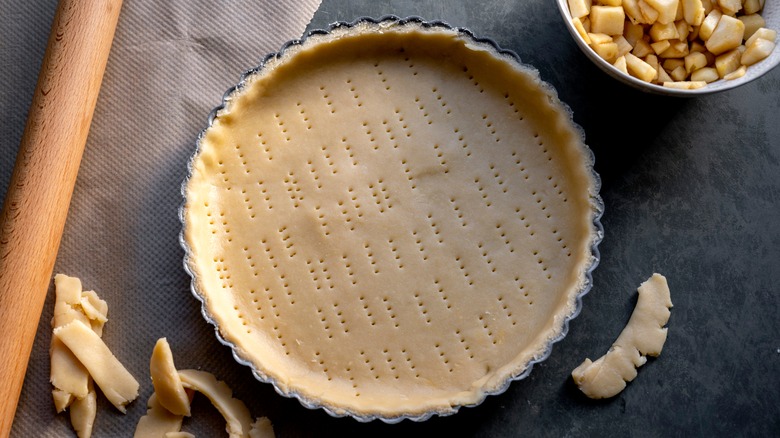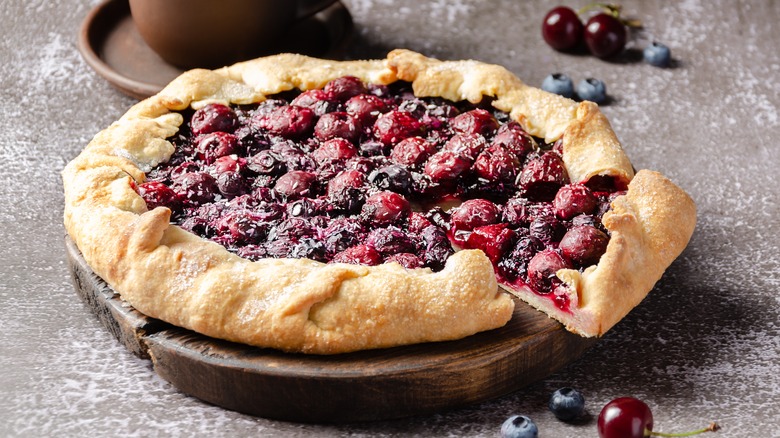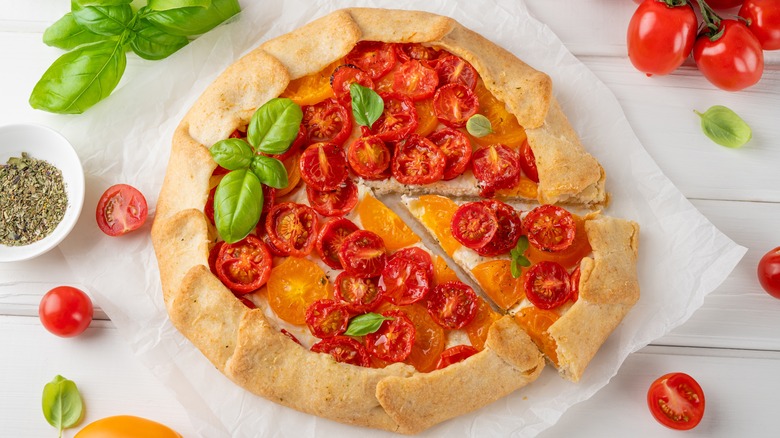Avoid Pie Crust Stress By Making A Freeform Alternative
Whether you're whipping up a delicious Dutch apple pie or tart lemon meringue pie, making the crust by hand can be a pain. Not only do you typically need a pie tin and pie weights, but Epicurious recommends owning a dough blender, pastry brush, and a paring knife to make all those pretty designs on a double-crust pie. If you're not a pie-making fanatic, all these tools may sit around in your kitchen unused, and they can be unnecessary expenses.
But the complications associated with pie crust don't end there. According to Land O'Lakes, there are a variety of techniques that should be followed to ensure a flaky, buttery crust. The butter should be cold when mixed with water so that gluten doesn't develop in the flour. After you've made your dough, it should be shaped into as perfect of a circle as possible so that it will fit nicely inside your pie pan. And if you've ever made a pie crust and it started to shrink down the sides of the pan, you know how frustrating that can be. According to Southern Living, this could be due to a variety of factors, including overworking the dough or not allowing it to rest.
While the crust-making process may be stressful, The Kitchn recommends making it as opposed to buying it for a better taste and texture. But if you want to whip up a delicious, homemade dessert and don't have the energy to sweat over shrinking dough, there is luckily an easier alternative.
Try a flexible, forgiving galette
Enter the galette, a free-form, rustic dessert similar to a pie, but with a few key differences that make it a much easier endeavor. While a galette may sound fancy, The New York Times explains that the crust is made by simply rolling out pie dough, adding fruit or other fillings, and folding the edges around the top. A galette can be whatever shape or size you like, and it can be baked on a good old baking sheet — no extra equipment necessary.
Another perk of galettes is that they're customizable. USA Today suggests using fruit, vegetables, cheese, meat, and more for your fillings. The flexibility gives you the freedom to try putting together delicious combinations like ricotta and pears, or vegetables with feta and herbs. If you're craving a classic fruit pie, either this Peach Galette or Apple Galette should do the trick. You'll want to use cold butter and chill the dough, just like you would for a regular pie crust. But when you roll it out, just try to make sure it's an even thickness, and don't worry too much about making a perfect circle.
Once you've placed your filling in the middle, try to create about a two-inch border over the sides — but again, we're not concerned about perfection here. If you want to get a little fancy, brush the folded edges with egg wash and sprinkle with turbinado sugar for extra crunch.
How to tell if your pie filling will work for a galette
While a galette may be a perfect vehicle for your favorite fruit, it's important to keep in mind that not every pie filling can be used here. Stick to chunky, jammy, or solid ingredients, as the liquid may cause a galette crust to fall apart or get too soggy. Stay away from recipes like custard pie, pumpkin pie, and key lime pie, which typically have a liquid filling. Instead, think of fruit pies like blueberry and strawberry, veggie-filled ones like heirloom tomato, and even meat-based recipes like chicken pot pie.
A pie recipe that doesn't use a typical pie crust is also generally difficult to transition into a galette. For example, Epicurious shares different ways to make a crumb crust, including using graham crackers, chocolate wafers, and ginger snaps. While these crusts may taste delicious with a creamy filling, they usually need a pie tin to keep them together. And while crustless pies may be extra rich and time-saving, they rely on a pan for their shape and generally don't work as galettes.
But don't let these few limitations deter you. While making a pie crust can be a headache-inducing task, galettes are incredibly versatile, delicious, and forgiving dishes.


